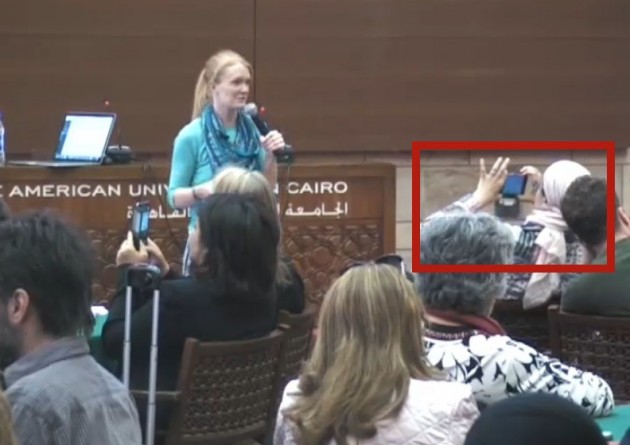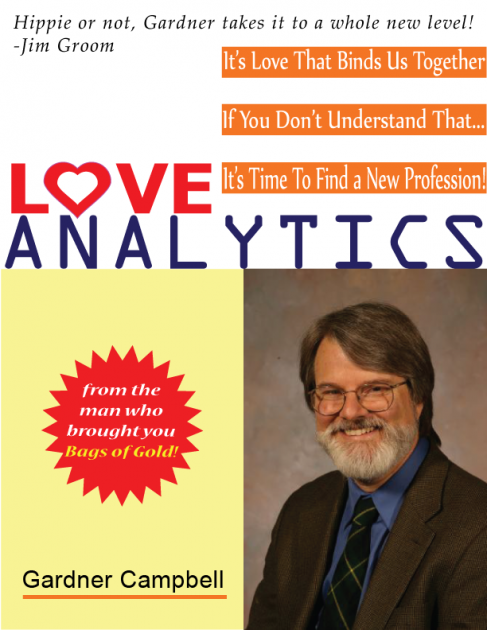Besides frequent topics here of dogs, photos, and sometimes catfishing, I do like to share the wonders of the humble link, the thing that connects one idea to another. They might be deliberately places, but I find more interesting are the ones we make, ones not built into any designed system.
Get ready for a link ride.
With some reading time over breakfast, I am following the activities of the Digital Pedagogy Lab going on this week in Cairo. Sure we wish we could be in Cairo, right? But there are many ways to participate from where ever you are.
After seeing some tweets, I decided to watch the archive of Amy Collie’s keynote on “Not Yetness” (I found the archive of all live streams by clicking a bit around the AUC Panopto site).
This is not a review of the talk, but by all means watch the whole thing. Amy rails hard against the rigidness of “learnification”. I paused somewhere a little after the 17:00 minute mark, noting the hands in the front row holding up a mobile phone in the recognizable spread-finger mode to take a photo of Amy (to keep them out of the lens, right, see top image).
I know who always sits in the front row! I bet that’s the event organizer Maha Bali. I wonder how I can tell. Hmm, if I look through her twitter stream…
We should be skeptical of mechanistic reductionist deterministic approaches – – @amcollier #digped pic.twitter.com/mVgIDZZztE
— Maha Bali, PhD ??? ???? ? (@Bali_Maha) March 21, 2016
That’s pretty wild, if you ask me. Through twitter, I can see now a different perspective in the room I am watching on the video. I decided to combine the images…
Listening to archive of @amcollier #NotYetness talk at #digped see @Bali_Maha take photo. Can I connect them? yep pic.twitter.com/3XjInrwToX
— Alan Levine (@cogdog) March 21, 2016
I just find this… well… interesting.
Later in her talk, Amy shares a summary of a talk given by Gardner Campbell, where he knocks the usual pyramid aside for one of student engagement with a surprise element at the top
Goosebumps around the room @amcolloer at keynote reveals LOVE at top of @GardnerCampbell taxonomy#digped pic.twitter.com/PirzytYLXU
— Maha Bali, PhD ??? ???? ? (@Bali_Maha) March 21, 2016
And this draws me back to a post I had read last night by Kate Bowles on Heresy and Kindness. She gave some kudos to fellow scholars who have shared freely their ideas in their own blogs:
I was really struck by how prolific, gifted and funny these writers were, and how they used their online writing as a way of reaching beyond the everyday of where they were to struggle with issues that were recognisable to me, all the way down here in Australia. But I also learned new things: refrigerators! fencing! NUFC! credit transfer! And all five of them made space in their comments for others to learn how to write publicly. For me, this was essential as I was still writing anonymously and worrying whether critique of my own employer’s business culture crossed some kind of line in terms of professional conduct.
So the first important lesson I learned from these five is that online writing is a practice of scholarly hospitality.
and…
And so writing for me was gently rescued from its service role in generating outputs for measuring, and returned to a closer relationship to enquiry. I learned how to write in order to think. Here were scholars producing a couple of thousand words a week without distress, contributing timely, relevant expertise to the history of human thought and if you had a question or objection, you could just bowl up and ask them, and they replied.
Isn’t this what we all think the academy is supposed to do in the world?
Kate’s words connect back directly to Amy’s talk “writing for me was gently rescued from its service role in generating outputs for measuring, and returned to a closer relationship to enquiry.”
I had left a comment about kindness being one of those things not evenly distributed but also noting that all the influences Kate mentioned (and including hers too) were writing in their own spaces.
When Kate replied directly to me (how quaint, a blogger who not only has comments open, but she responds as well?), I found myself thinking of a Gardner Campbell story of my own:
Which leads me to remember a story… In 2011 at the EDUCAUSE ELI conference, I was in the room with Gardner Campbell being interviewed for a podcast (that was never published); when he was asked about the potential of learning analytics he went on this poetic rant about why are we not applying analytics to love.
There were more than 4 people in the room. I was experimenting with live radio streaming via DS106 radio, and our friend @noiseprofessor in California was listening, and generated/tweeted this lovely Photoshop remix before we left the room
How do you ever measure this experience? Why does the electric excitement of it remain with me 5 years later than I can still visualize the room?
Now I am not 100% sure of the connection I was making with Kate’s post, most likely that the stuff of connection, the non-tangible links not coded as hypertext, may have some sprinklings of love in it.
But then it circles back, since I think Gardner saw the tweets, and pulled out his own memory palace entry, tweeting @noiseprofessor, who then responded with an updated image:
@GardnerCampbell @amcollier @Bali_Maha In need of an update – Haters Hate Him! https://t.co/ggd2ko43CM
— Zack Dowell mastodon.social/@noiseprofessor (@noiseprofessor) March 21, 2016
None of this playfulness seems connected to anything that might resemble a competency or something that fits in a box on the rubric. Why do we do this unconnected connecting?
I’d say look to the top of the pyramid- it’s not down there in the compliance layer.
PS- Do you want to tap into the DigPed happenings in Cairo? There are two more Virtually Connection sessions scheduled – I am hosting one Wednesday, and there are a few seats left at the hangout table.
Top / Featured Image: This took some bouncing around. Searching Google Images for open licensed images for “human link” had too many evolution diagrams and some bizarre images. I went to my own well of flickr photos just searching on “link”, but it was too many chains and literal links. I was after the human side of the metaphor, so I just searched my own photos on “hands”.
This one I found was way down the list! But The ghostly image of my hands reflected in a bookcase had a nice feel for the concept of a human connection between the ideas in the books (the reflection made the iphone camera in my hand barely visible). It turned out even more linked better, since this photo was taken at Gardner Campbell’s home, and he appears in this post.
It seems meant to me.
That is my flickr photo https://flickr.com/photos/cogdog/10412749766 shared under a Creative Commons (BY) license




Interestingly, too, is that Kate’s post links to one of mine where I talk about love and anger in postcolonial being. Referring to DigPedCairo. Funnier – as I am writing this comment, someone just tweeted that blogpost! Not sure who!
This unconnected connecting: it’s something uncanny that I get out of working in Mike Caulfield’s various studio spaces (including with you). Sitting invisibly beside someone else working on their own writing and being able to lean over and loop my thread through theirs without disturbing them—I can’t begin to describe how this makes me feel. But I suspect it has to do with being an introvert who quite enjoys the company of extroverts, and probably what took me online in the first place.
This post and the following one about comments has me thinking about what loops over time have to do with this. To know that someone comes back years later to explain something is to know something about your own mortality.
I’m a card carrying introvert too. I’d rather write blog posts than be in a noisy room of people. But I crave to be in a noisy room of people I’ve met through these channels.
Your words about time loops are reverberating strongly. They were, as comments go, unexpected and powerful. Thanks from across space and time.
I say, “Life likes to rhyme.” If we surrender to the flow, we may be guided by serendipity, visions and dreams. The shamanic world is only a couple of dermal levels down for those who, like you, have eyes to see.
Gardner Campbell is a lovely human being, and an inspired teacher, learner and communicator. It’s not surprising to me that he would have love at the top of the pyramid. Delighted to read your post. I agree. Links across time and space. It’s us. Here’s to continued inspired linking, thinking, applying.